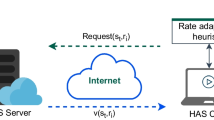Abstract
With the proliferation of digital video and the popularity of video streaming applications, it is highly desirable to find and access video segments of interest by searching through the content of video at a speed that is faster than a normal playback. The key functions that enable quick browsing of video are fast-forward and fast-reverse playbacks. However, motion-compensated prediction adopted in the current video coding standards drastically complicates these operations. One approach to implement the fast-forward/reverse playback is to store an additional reverse-encoded bitstream in the server. Once the client requests a fast-forward/reverse operation, the server can select an appropriate frame for the client from either the forward-encoded bitstream or the reverse-encoded bitstream by considering the cost of network bandwidth and decoder complexity. Unfortunately, these two bitstreams are encoded separately. The frame in one bitstream may not be exactly identical to the frame in another bitstream. If one of these frames is then used as the reference for the requested frame, which is in another bitstream, it induces mismatch errors. In this paper, a novel H.264 dual-bitstream system aiming at providing the fast-forward/reverse playback based on SP/SI-frames is proposed. The proposed system can completely eliminate mismatch errors when the frame in the reverse-encoded bitstream replaces the frame in the forward-encoded bitstream and vice versa. Experimental results confirm that the proposed system is effective in eliminating mismatch errors so as to enhance the performance of the dual-bitstream system.








Similar content being viewed by others
References
Stockhammer, T., Jenkac, H., & Kuhn, G. (2004). Streaming video over variable bit-rate wireless channels. IEEE Transactions on Multimedia, 6(2), 268–277.
Ganjam, A., & Zhang, H. (2005). Internet multicast video delivery. Proceedings of the IEEE, 93(1), 159–170.
Real Networks RealPlayer [Online]. http://www.real.com/. Accessed 24 December 2009.
Microsoft Window Media, Microsoft Corporation Inc. [Online]. http://www.microsoft.com/windows/windowsmedia/. Accessed 24 December 2009.
SonicBlue Inc. [Online]. http://www.replay.com/. Accessed 24 December 2009.
TiVo Inc. [Online]. http://www.tivo.com/. Accessed 24 December 2009.
ISO/IEC 11172-2: ‘Information Technology—Coding of Moving Pictures and Associated Audio for Digital Storage Media at up to about 1.5 Mbit/s—Part 2: Video’, 1993.
ISO/IEC 13818-2: ‘Information Technology–Generic Coding of Moving Pictures and Associated Audio Information: Video’, 1996.
ISO/IEC 14996-2: ‘Coding of Audio-visual Objects—Part 2: Visual’, 2001.
ITU-T Rec. H.263: ‘Video Coding for Low Bitrate Communication’, 1997.
ISO/IEC 14996-10 and ITU-T Rec. H.264: ‘Advanced Video Coding’, 2003.
Srinivasan, R., & Rao, K. R. (1985). Predictive coding based on efficient motion estimation. IEEE Transactions on Communication, 33(9), 1011–1015.
Hui, K. C., & Siu, W. C. (2007). Extended analysis of motion-compensated frame difference for block-based motion prediction error. IEEE Transactions on Image Processing, 16(5), 1232–1245.
Chan, Y. L., & Siu, W. C. (2001). An efficient search strategy for block motion estimation using image features. IEEE Transactions on Image Processing, 10(8), 1223–1238.
Lin, C. W., Zhou, J., Youn, J., & Sun, M. T. (2001). MPEG video streaming with VCR functionality. IEEE Transactions on Circuits and Systems for Video Technology, 11(3), 415–425.
Huang, S. Y. (2003). Improved techniques for dual-bitstream MPEG video streaming with VCR functionalities. IEEE Transactions on Consumer Electronics, 49(4), 1153–1160.
Ip, T. P., Chan, Y. L., & Siu, W. C. (2008). Redundancy reduction technique for dual-bitstream MPEG video streaming with VCR functionalities. IEEE Transactions on Broadcasting, 54(3), 412–418.
Fu, C. H., Chan, Y. L., & Siu, W. C. (2006). Efficient reverse-play algorithms for MPEG video streaming with VCR support. IEEE Transactions on Circuits and Systems for Video Technology, 16(1), 19–30.
McManus, J. M., & Ross, K. W. (1996). Video-on-demand over ATM: constant-rate transmission and transport’. IEEE Journal on Selected Areas in Communications., 14(6), 1087–1098.
Fung, K. T., Chan, Y. L., & Siu, W. C. (2002). New architecture for dynamic frame-skipping transcoder. IEEE Transactions on Image Processing, 11(8), 886–900.
Tan, Y. P., Liang, Y., & Yu, J. (2002). Video transcoding for fast forward/reverse video playback. Proceedings of International Conference on Image Processing, 713–716.
Omoigui, N., He, L., Gupta, A., Grudin, J., & Sanocki, E. (1999). Time-compression: system concerns, usage, and the benefits. Proceedings of ACM SIGHI Conference, 136–143.
Karczewicz, M., & Kurceren, R. (2003). The SP- and SI-Frames design for H.264/AVC. IEEE Transactions on Circuits and Systems for Video Technology, 13(7), 637–644.
Kurceren, R., & Karczewicz, M. (2002). Synchronization-predictive coding for video compression: the SP frames design for JVT/H.26L. Proceedings of IEEE International on Conference Image Processing, 2002, 497–500.
Lai, K. K., Chan, Y. L., Fu, C. H., & Siu, W. C. (2008). Viewpoint switching in multiview videos using SP-frames. Proceedings of the IEEE International Conference on Image Processing, 1776–1779.
Lai, K. K., Chan, Y. L., & Siu, W. C. (2007). A quantized transform-domain motion estimation technique for H.264 secondary SP-Frames. Proceedings of the 8th Pacific Rim Conference on Multimedia, 128–137.
JVT Reference Software JM15.1 [Online] http://iphome.hhi.de/suehring/tml/download/. Accessed 24 December 2009.
Acknowledgements
The work described in this paper is partially supported by the Centre for Signal Processing, Department of Electronic and Information Engineering, Hong Kong Polytechnic University and a grant from the Research Grants Council of the Hong Kong Special Administrative Region, China (PolyU 5120/07E). Li-Kit Lai acknowledges the research studentships provided by the University.
Author information
Authors and Affiliations
Corresponding author
Rights and permissions
About this article
Cite this article
Chan, YL., Ip, TP., Lai, KK. et al. A New Dual-bitstream Video Streaming System with VCR Functionalities Using SP/SI-frames. J Sign Process Syst 62, 403–414 (2011). https://doi.org/10.1007/s11265-010-0472-y
Received:
Revised:
Accepted:
Published:
Issue Date:
DOI: https://doi.org/10.1007/s11265-010-0472-y




